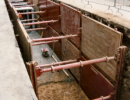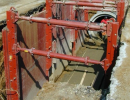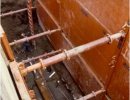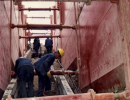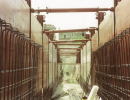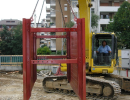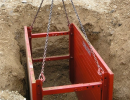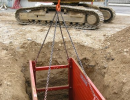Trenchlining

Trenchlining system (retainers using earth retaining formworks, formwork systems for canalizations, formwork for sewer systems and excavations) designed to ensure safety during worksite operations.
Trenchlining: BOX SICURO and DOWN Pilosio trenchlining system with earth retaining formworks, formwork systems for canalizations, formwork for sewers
The DOWN retaining system allows the support and reinforcement of the excavation walls, thereby drastically resolving the issue of safety and protection in the creation of canalizations and sewer systems.
It is Modular, stackable, and available in three models:
- with a caisson,
- with simple guiding,
- with double guiding,
which can be all be integrated among themselves to resolve all your jobsite requirement and needs.
The structure designed for earth pulls up to 4000 daN/m2 , allows for the realization of excavations up to 7m in depth and 5m in width, and in absolute safety for the workers; the system European regulations EN 13331-1/2.
DOWN WITH A CAISSON
- Base panel: 315x230cm 815Kg
- Elem. of superelevation :315x120cm
- Maximum depth: 4m
- Width of the ditch: from 0,82m to 3m
- Continuous seal: no
Ideal for the containment of soil when making sewer systems or aqueducts; reaches a width that goes from 1.3 to 1.5m; larger widths can be attained with the help of extensions (up to 3m). The caissons can be joined together so as to obtain a continuous connection.
DOWN WITH SIMPLE GUIDING
- Base panel: 315x230cm 739Kg
- Elem. of superelevation: 315x120cm
- Maximum depth : 5m
- Width of the ditch: from 0,82m to 5m
- Continuous seal: yes
DOWN with simple guiding can have a width that is adjustable and goes from 1.05 to 1.45m; greater widths (up to 5m) are obtained by inserting extensions. The system is ideal if you want to have a continuous armouring of up to 5m in depth, and can be used as a formwork for the casting of concrete into the excavation.
DOWN WITH DOUBLE GUIDING
- Base panel: 315x230cm 739Kg
- Elem. of superelevation:315x120cm
- Maximum depth : 7m
- Width of the ditch: from 0,82m to 7m
- Continuous seal: yes
DOWN with double guiding allows you to inset two parallel panels and a superelevation panel. This allows you to remove the underneath panel leaving the other one inserted, thus preventing landslides within the excavation. The big contrasting screws can be fastened (buttonhole system) at positions where they do not impeed works.
On the right you will find the outline for the use of the DOWN with Double Guiding system.
With the DOWN single guiding and double guiding systems, which are suitable for terrains that are especially crumbly, the descent of the panels during the excavation phase protects the ditch and prevents the caving-in of the excavation’s wall brackets. The positioning of the individual elements occurs using the same excavator used for the excavation.
During the DOWN with a caisson instead, which is more suitable to soils of a greater consistency, the system can be set down into the soil already assembled.
The “SAFE BOX” retaining system was created to guarantee maximum safety and protection for work in non-continuous ditches with soil that has good consistency. Its simplicity and lightness allow you to achieve high standards of safety for work in excavations, thus saving time and work costs.
It is made up of a pair of opposite metal panels which are connected by telescopic spacers, and it allows for excavations up to a maximum depth of 3.5m (with the use 1.2 m superelevation) and a lower clearance of at least 1.0m.
The solidness of all the materials allows you to always count on the panels’ maximum capacity irrespective of the width.
The 2250 N/m2 seal is guaranteed up to a maximum opening of 2.15m.
BOX is put to use already assembled with the help f medium-strength lifting tools like a backhoe loader.
To do the placing, you make a hole whose dimensions are in plan with the caisson in such a way that the BOX, which was previously mounted outside of the soil, can be laid out vertically.

